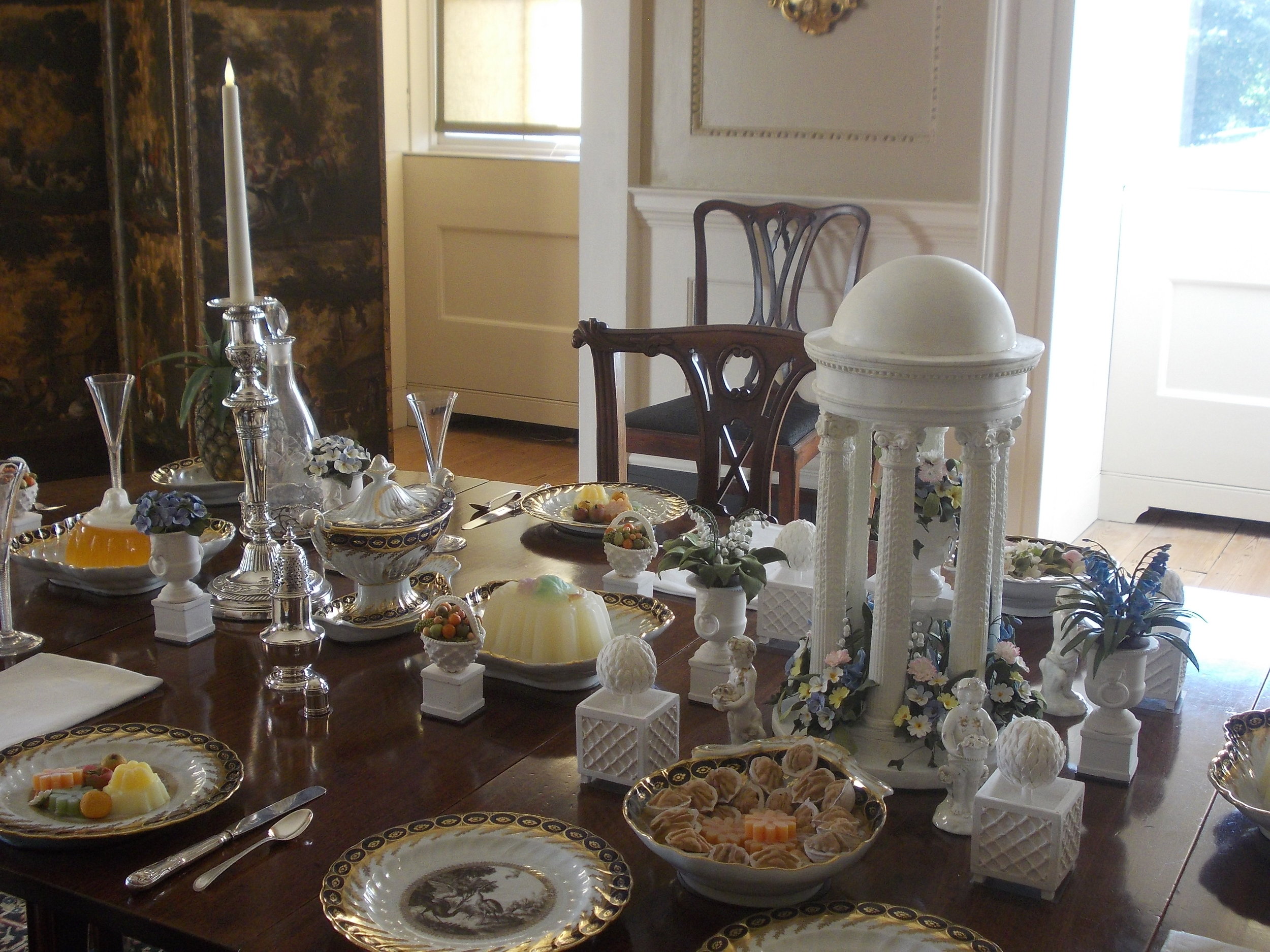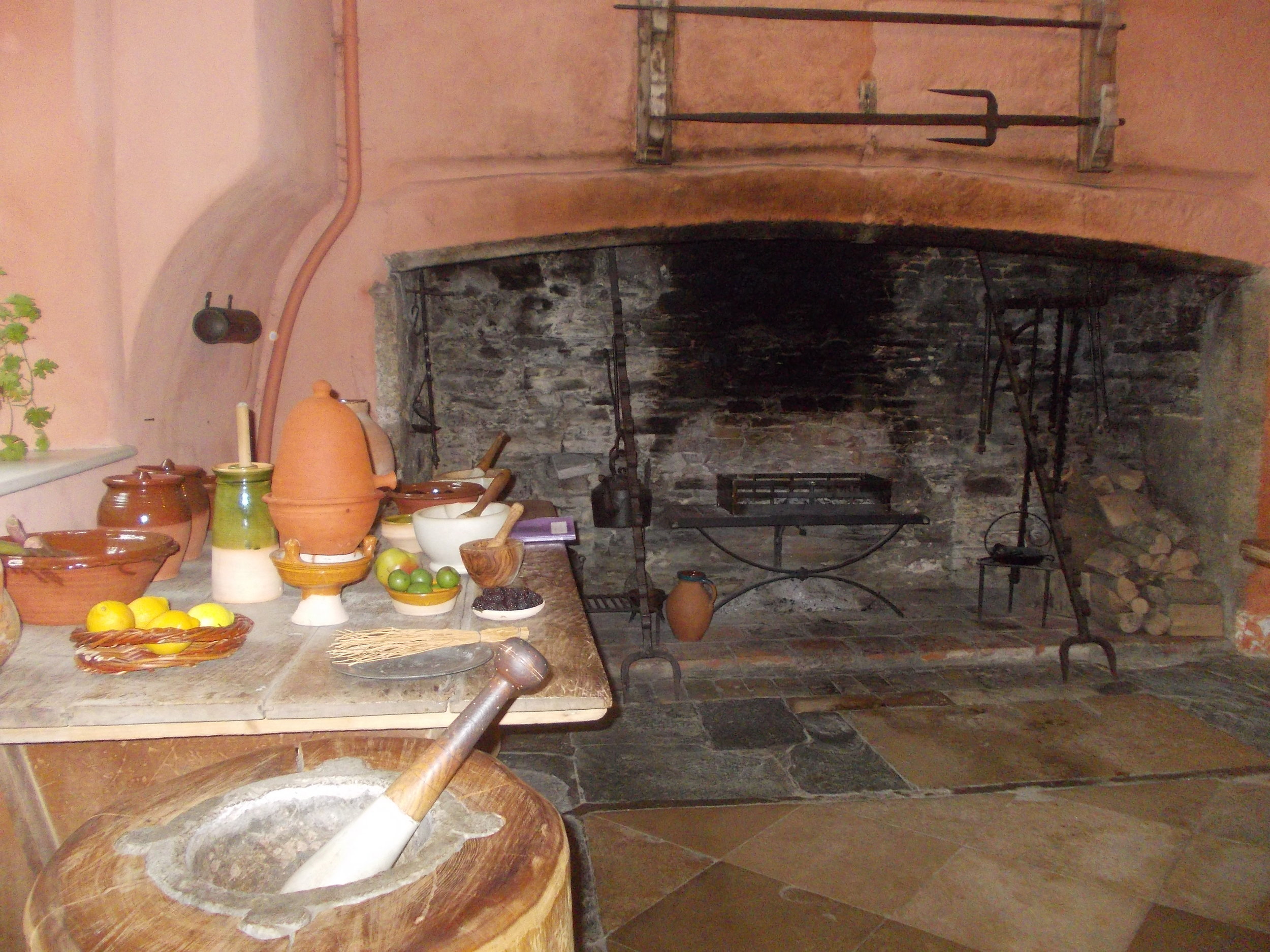JOIN US FOR AN EXCITING TOUR OF A GEORGIAN KITCHEN!
The dinner […] was highly admired; and he begged to know to which of his fair cousins the excellence of its cookery was owing. But here he was set right by Mrs Bennet, who assured him with some asperity that they were very well able to keep a good cook, and that her daughters had nothing to do in the kitchen. (Pride and Prejudice, Chapter 13).
Jane Austen’s novels entice us into the world of her characters, making us want to know everything about them. Not just how they cut a path in life, but how they lived. What did they wear? What did they eat? How did they travel? How did they amuse themselves? What did Jane Austen’s England really look like? But our favourite author is not one for lengthy descriptions. Unlike Rev. James Woodforde, who diligently recorded his social engagements and the delights of his table, Jane Austen is very economical with such details. If she mentions something as mundane as food in her novels, it’s only to indirectly tell us more about her characters.
With the snobbery of a social climber, Mrs Bennet points out to Mr Collins that her daughters have no business in the kitchen, and she does not miss the chance to make a snide remark to Mr Bingley that unlike her daughters, who were ‘brought up very differently,’ Charlotte Lucas must have been wanted at home to help with the mince pies.
The irony is there, for us to be ruefully amused at the thought that it’s the very same disparaged Charlotte who might eventually supplant Mrs Bennet as the mistress of Longbourn, and her culinary talents might have played a part in recommending her to Mr Collins, who was so keen to discover which one of his potential brides was the best cook.
We are also told that, to his housekeeper’s dismay, the generous Mr Knightley had given his last apples to the less fortunate Miss Bates, her mother and her niece; that the indolent Mr Hurst could find nothing to discuss with Elizabeth beyond his fondness for ragout; that the kindly but supremely tactless Mrs Jennings offered Marianne sweetmeats, olives, dried cherries and a glass of Constantia wine as a cure for her heartache over Willoughby. We are treated to Mrs Bennet’s monologue about the successful dinner she had hosted – venison roasted to a turn, soup fifty times better than the one served at Lucas Lodge, partridges remarkably well done – and we hear her speculating that Mr Darcy must have at least two or three French cooks.
Jane Austen’s heroes and heroines don’t prattle on about food. Neither do the other characters whom we are encouraged to respect. That office is left to the likes of Mrs Bennet, Miss Bates, Mrs Jennings, Mr Woodhouse or Mrs Norris. Thus, we are never to learn if Mr Darcy does indeed employ French cooks, nor what elegant dinners are served at Pemberley. If we would like more details about the world of Jane Austen’s characters, we must seek them elsewhere.
The delightful dining room at No. 1 Royal Crescent in Bath might give us an idea of what dinners at Pemberley might have looked like:
Meat course, No. 1 Royal Crescent, Bath (Photo: J Starnes)
Dessert course, No. 1 Royal Crescent, Bath (Photo: J Starnes)
As for those who toiled to prepare such delicacies, The Complete Servant, written by Samuel and Sarah Adams, upper servants themselves, tells us that a country gentleman with a young family and an income of £16000 a year would be expected to employ at least 26 indoor and outdoor servants, among which a housekeeper, ‘a French Man-Cook’, one or two kitchen maids, two dairy maids, a still-room maid and a scullery maid (also known as a scullion). On her husband’s income, Mrs Bennet would have had to make do with a housekeeper, a cook (probably female, and certainly not French), a kitchen maid and a scullion, while on their £500 a year Mrs Dashwood, Elinor and Marianne could only have a cook and a maid-of-all-works in their kitchen at Barton Cottage.
The Complete Servant is just a guide, and in practice the number of servants varied. For example, in 1819 the 5th Earl of Stamford’s household included a housekeeper, an English cook (male), four kitchen maids, a dairy maid and two still-room maids. Most of them were expected to travel with the family between the London townhouse and the two country estates, Enville and Dunham Massey.
Even if the family did not belong in the highest circles and did not entertain lavishly, cooking for the Georgians was no mean feat. In most houses, grand or humble, cooking was still done over an open hearth, as had been the case for centuries.
Buckland Abbey, National Trust (Photo: J Starnes)
Charlecote, National Trust (Photo: J Starnes)
No. 1 Royal Crescent, Bath (Photo: J Starnes)
Pots, kettles and griddle pans were suspended over the fire from wrought iron cranes that allowed them to be raised, lowered, or swung out. The meat was roasted on spits worked by a mechanical device (#1 in the image below) or by a smoke-jack in the chimney (a vane turned by the upward current of hot air and smoke). A hastener (2) might be used, so that the joint would be exposed to heat on all sides.
Georgian kitchen, No. 1 Royal Crescent, Bath (Photo: J Starnes)
Delicate sauces that required gentler handling were prepared on a hotplate heated by a flue running under it, and bringing hot air from the nearby fire (in its place, in the kitchen of No. 1 Royal Crescent there is now a modern appliance (3) used for cooking demonstrations, but the image below still shows the original hotplate).
Buckland Abbey, National Trust (Photo: J Starnes)
Most of the time, a fire was also burning under a large lidded copper vessel (#4 in the Royal Crescent image) to provide a constant supply of hot water for the kitchen and the rest of the household. Bread was baked in a separate brick oven that could be found either in the kitchen or in the bakehouse. Kitchen ranges started making an appearance from 1780, and included a closed oven to one side and a boiler on the other.
A housekeeper worth her salt would also supervise the preparation of pastries and confectionery in an adjoining pastry room (unless the household was grand enough to employ a pastry-cook for the purpose), and she would also oversee the still-room maids in the preparation of household remedies and cosmetics.
What the Georgians lacked in labour-saving modern-day appliances, they certainly made up in the variety of utensils. No. 1 Royal Crescent in Bath houses one of the largest collection of kitchen implements, ranging from a coffee beans roaster (5) and sugar clippers (6) to pie and jelly moulds, butter stamps, butter scales, spinach presser, cabbage presser, toasting rack, ale muller, apple corer, potato slicer, vegetable chopper, pastry cutters, pigeon skewers, pewter plates, whisks, scoops and saucepans of all shapes and sizes.
Utensils, No. 1 Royal Crescent, Bath (Photo: J Starnes)
To our good fortune, records of the time, including the collection of recipes compiled by the Austens’ friend Martha Lloyd, allow us to discover what might have been prepared with the aid of those implements. We might never sit down for a true Georgian dinner. We might not have enough time and courage to attempt to cook Sauté of pheasants with truffles, Turbot with lobster sauce, Partridge galantines or Salmagundy – and indeed we might lack the sturdy constitution needed to consume them. Yet, thankfully, we can find enough fodder for our imagination to be able to picture dinners at Pemberley, Netherfield, Donwell or Enscombe, with glittering plate, cheerful and animated company, and tables so laden that the mere thought of them would make Mr Woodhouse blanch and ring for his basin of thin gruel.
© Joana Starnes – author of Jane Austen fiction. Visit her on her website, Facebook or Twitter.
References:
Adams, Samuel and Sarah – The Complete Servant (1825). Edited by Ann Haly, introduction by Pamela Horn (1989), Southover Press.
Black, Maggie and La Faye, Deirdre – The Jane Austen Cookbook (1995), British Museum Press.
Lane, Maggie – Jane Austen and Food (1995), Hambledon Press.
Murray, Venetia – High Society in the Regency Period (1998), Penguin Books.
Quennell, Marjorie and C.H.B – A History of Everyday Things in England (1960), Batsford.
Sambrook, Pamela – A Country House at Work, Three Centuries of Dunham Massey (2003), The National Trust.
Woodforde, James – The Diary of a Country Parson 1758 - 1802 (1978), Oxford University Press
To subscribe to Pride & Possibilities, the Jane Austen Literacy Foundation Journal, enter your details at the bottom of the page.
Image credit: The dining room table at Attingham Park. ©NTPL/David Levenson










